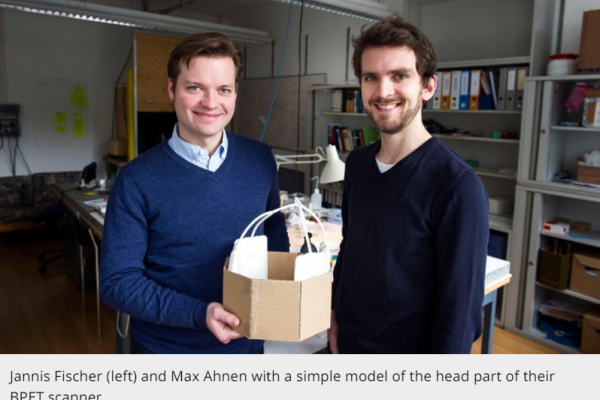New brain scanner could provide earlier diagnosis of dementia
The two ETH particle physicists are building a brain scanner that is ten times less expensive and much smaller than current models.
The two ETH particle physicists are building a brain scanner that is ten times less expensive and much smaller than current models. Their ground-breaking work has earned them a place on the 2018 "30 Under 30" list published by the American business magazine Forbes . Forbes compiles this list every year to recognise “the most intelligent young entrepreneurs and inventors” in different disciplines.
They are barely thirty years old and are already actively involved in improving the diagnosis of Alzheimer’s disease. Max Ahnen (29) and Jannis Fischer (30) are developing a PET brain scanner that is not only less expensive, but also much more compact than those currently installed in hospitals.
PET scanners can help to diagnose certain neurological health conditions 10-20 years before doctors are able to do so by assessing the patient’s physical symptoms. The problem is that today, this is not done because these devices are very large and expensive.
At ETH Zurich’s Institute for Particle Physics and Astrophysics, Ahnen and Fischer are working to improve this situation. The project was initiated by researchers and doctors from the University of Zurich and the University Hospital of Zurich. The provisional name for their invention is Brain PET (BPET) and it will be used to identify neurological disorders. These include brain tumours and diseases of the nervous system, such as amyotrophic lateral sclerosis, Parkinson’s and Alzheimer’s disease, all of which cause dementia.
“It looks a bit like a hair salon chair with an integrated hairdryer hood,” Ahnen says. Because of its size, it is much more mobile than conventional machines.
Not only does the Brain PET technology cost less, but it is cheaper to use. The higher the frequency of use, the lower the cost of the radioactive tracer substances. PET scanners are currently the most expensive type of imaging equipment used in modern clinics, and many hospitals are unable to afford them. Fischer says: “We will be able to reach much wider sections of the population than in the past.”
New company about to be set up
BPET only exists on paper so far. The two scientists are currently in the process of setting up their new company, Positrigo, while also finishishing the construction of the prototype by September 2018. The financing is already in place: in June 2017 they won a Pioneer Fellowship.
The scientists hope to bring Brain PET onto the market in 2021. They claim this goal is “optimistic, but also realistic”. The timing is important: this date is also when many pharmaceutical companies plan to launch new Alzheimer’s drugs. The idea behind these drugs – fitting to early PET diagnosis – is that they can be used to combat dementia causing diseases before there is any physical deterioration of the cerebral matter.
www.ethz.ch





Related Posts